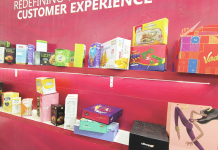
In end-January 2017, Creative Edge Software released Version 4.1 of its awardwinning iC3D all-in-one multi-function packaging visualization application. Among a range of updates designed to augment its already available photorealistic capabilities, the new version includes the company’s latest technological advance, Bump Displacement, also known as Displacement Mapping.

can create unique 3D shapes and
surfaces to convey a higher pedigree
of product
The new feature expands the potential for designers to create unique 3D shapes and surfaces, providing a greater sense of depth, detail and photographic accuracy. The Bump Displacement feature in iC3D enables packaging creatives to quickly create and visualize emboss or deboss design features to a photorealistic standard in a matter of minutes. The development is of particular relevance to the luxury and security packaging sectors where unique and complex shapes in glass, plastic and carton are used to distinguish premium products and ensure that they are more difficult to copy.
Previously, to achieve photorealistic mockups or proofs of emboss/deboss design devices required the use of high-end specialist, proprietary software applications. With iC3D’s Bump Displacement designers can achieve the same visual effect with a simple Illustrator file using the same all-in-one iC3D software that performs every other packaging design visualization application, including labels, pouches, shrink-wraps and shelf visualization.
According to Nick Gilmore, chief executive officer of Creative Edge Software, the beauty of the iC3D Bump Displacement feature is its simplicity and speed. “Luxury brands use selective embossing and debossing to convey a higher pedigree for their products. It’s the very complexity of producing the packaging that distinguishes it from regular high-street brands,” he explains. “Nevertheless, through meticulous research and development, our software designers have delivered the programming that can visualize these complex techniques, realistically and in real-time.”
The Bump Displacement feature of iC3D v4.1 allows the user to take a line drawing, logo or any shape created in Adobe Illustrator, and apply it to the surface of a carton, glass, plastic, or metal object, but working in real time. Simple sliders are then used to choose the depth of emboss or deboss. Once satisfied with positioning, size and style of emboss/deboss, iC3D Ray Tracing can be applied to accurately simulate the effects of light on the object and produce a photorealistic, ultra-high-resolution photo studio effect. As with all iC3D mockups, the 3D results can then be scrutinized from all angles by brand owners, production engineers and other stakeholders using iC3D Opsis via any web browser on any smartphone, tablet or computer.
“We feel very satisfied with the latest developments in iC3D v4.1,” said Gilmore. “In iC3D, we pride ourselves on having the most versatile, and affordable, packaging design application on the market, and this is yet another step towards making the best capabilities available to all. After all, just because creatives are working on luxury brands, that doesn’t mean they can afford luxury price tags on the everyday tools they need.”










